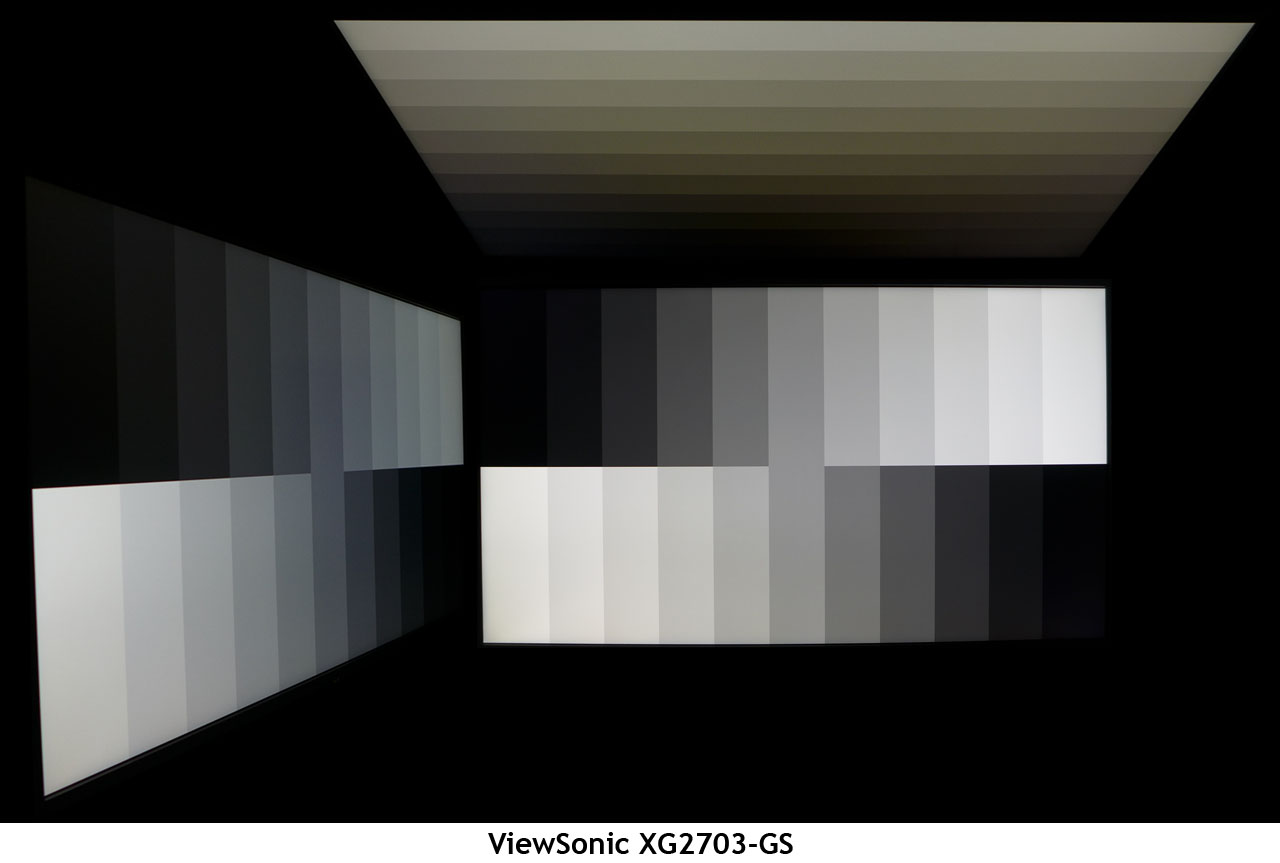ViewSonic XG2703-GS QHD G-Sync Monitor Review
Why you can trust Tom's Hardware
Viewing Angles, Uniformity, Response & Lag
Viewing Angles
AHVA panels offer the best viewing angles of any LCD technology. Our photos show only about a 30% drop in output to the sides and a blue color shift. Detail remains about the same, which means gamma stays consistent as you move off-axis. From the top, you can still see all the steps, but we’ve lost more light and the color is now tinted a reddish-green. This is better performance than you’ll see from typical IPS screens and certainly an improvement over any TN display.
Screen Uniformity
To learn how we measure screen uniformity, please click here.
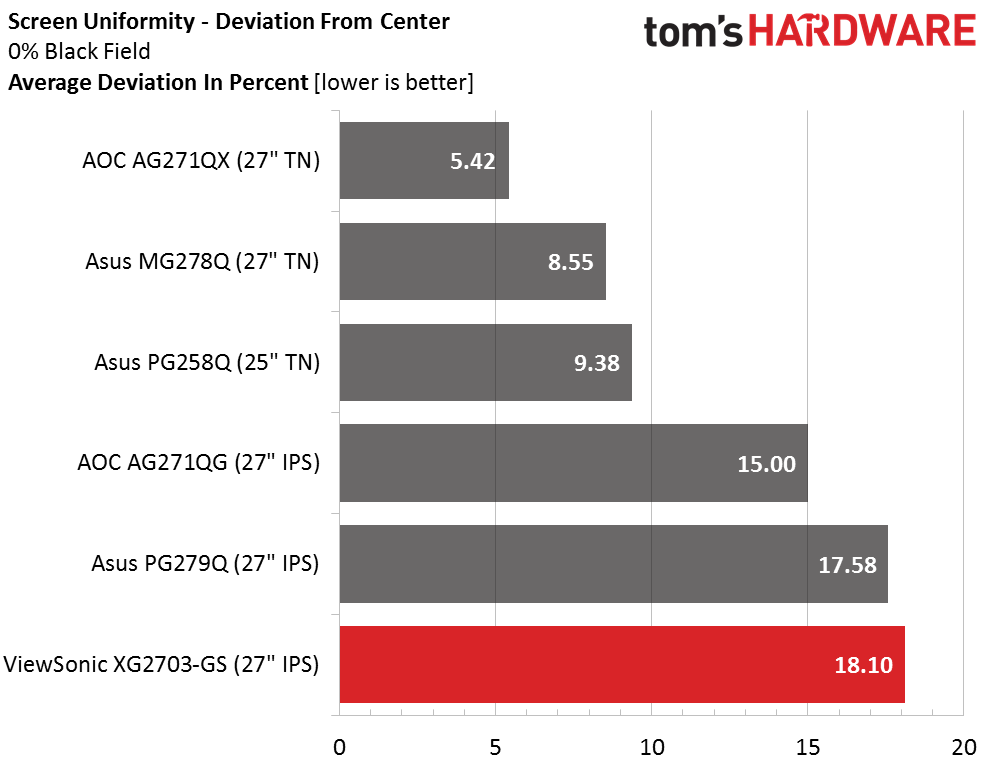
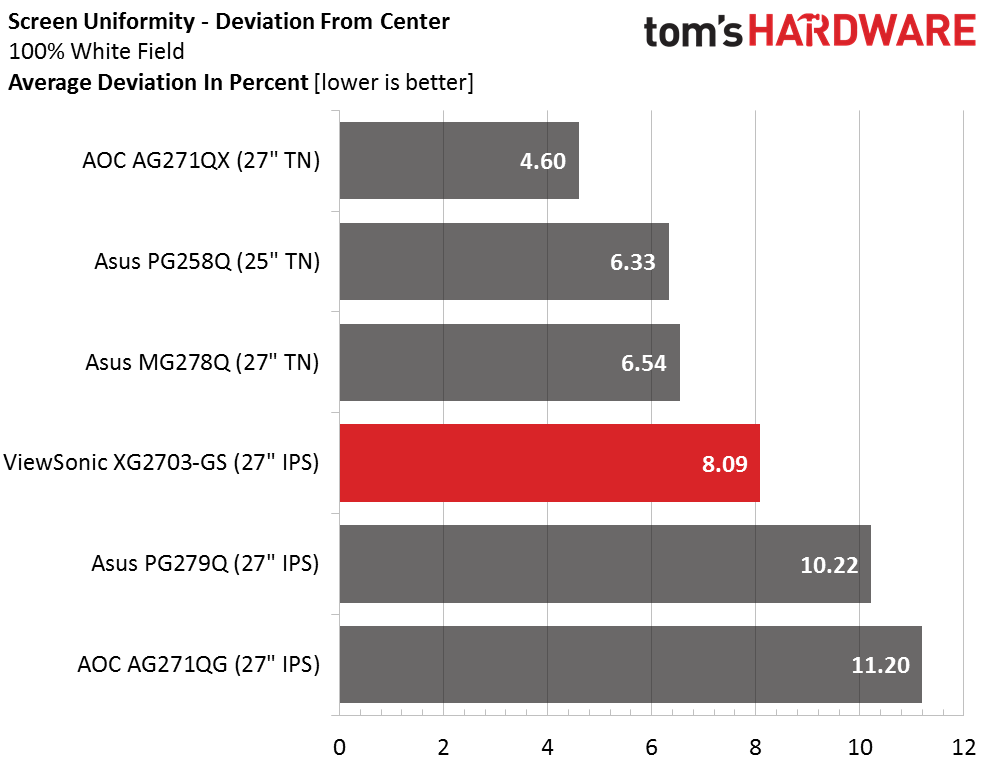
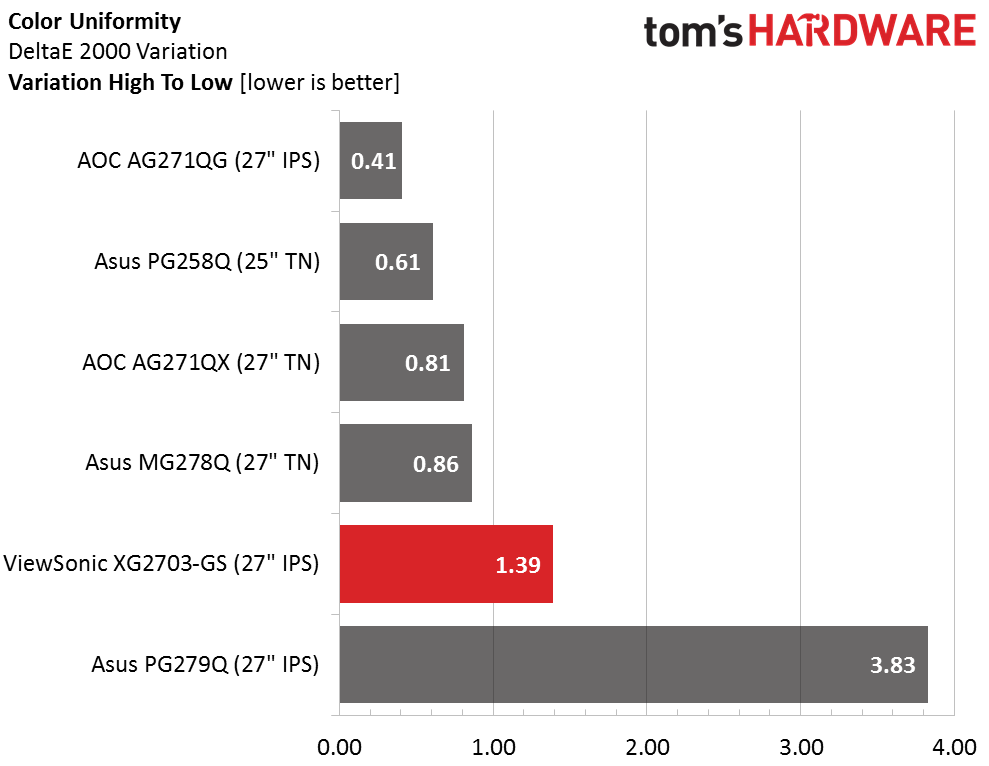
Even before taking measurements, we can see some light bleed in our XG2703-GS’s corners. It disappears when taking the light level above black, but it means a last-place finish in our test. The culprit is a tight-fitting anti-glare layer. It’s that way by design. A smaller gap means an increase in clarity, and this monitor certainly has that. By the time you get to maximum brightness, the uniformity has become visually perfect. Color uniformity is equally strong with no visible flaws anywhere.
Pixel Response & Input Lag
Please click here to read up on our pixel response and input lag testing procedures.
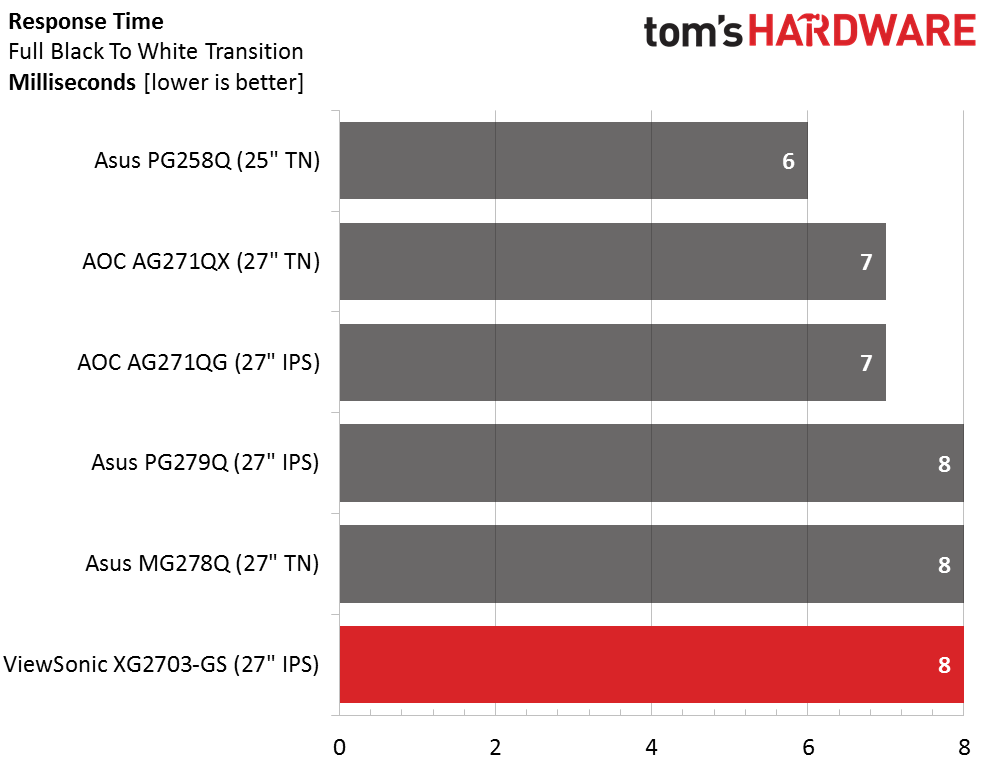
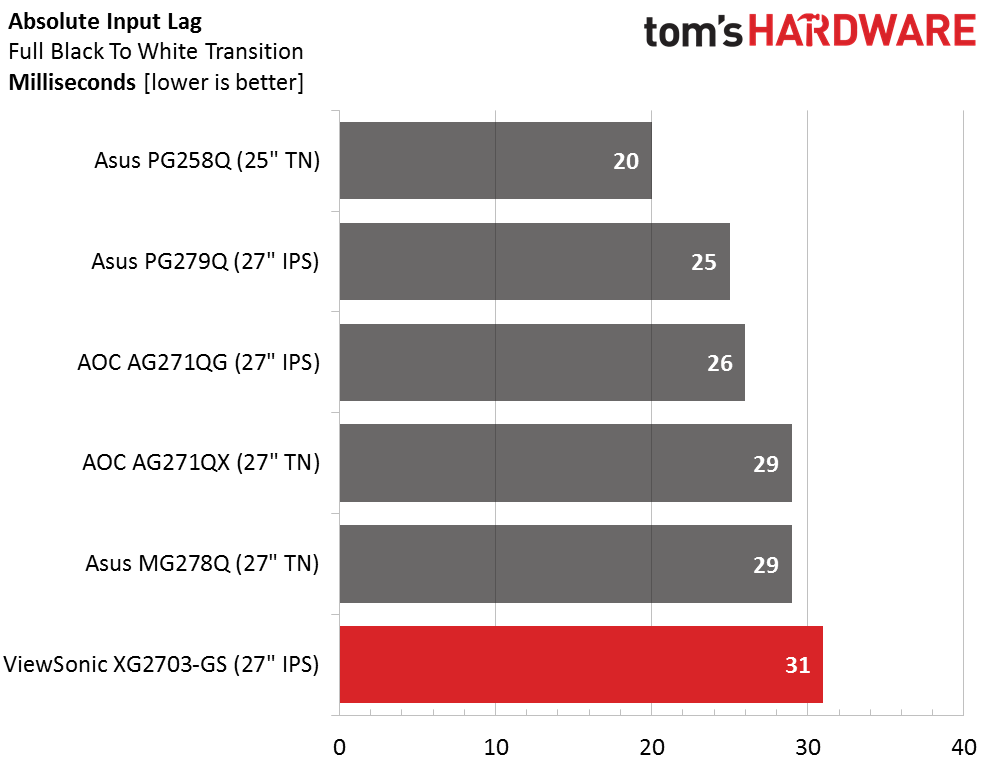
While last place may seem to be a let down, notice that the numbers are pretty close. Panel response spans a mere 2ms from top to bottom, an imperceptible amount. And input lag only covers 6ms when you don’t count the almost freakish PG258Q. So gamers have to decide between the bit of extra speed offered by TN screens and the superior viewing angles and image quality of IPS. For the vast majority of players, the XG2703-GS will perform just fine. But don’t decide just based on benchmark results. Check out our real-world observations below.
MORE: Best Computer Monitors
MORE: How To Choose A Monitor
Get Tom's Hardware's best news and in-depth reviews, straight to your inbox.
MORE: All Monitor Content
Current page: Viewing Angles, Uniformity, Response & Lag
Prev Page Color Gamut & Luminance Next Page Gaming With G-Sync
Christian Eberle is a Contributing Editor for Tom's Hardware US. He's a veteran reviewer of A/V equipment, specializing in monitors. Christian began his obsession with tech when he built his first PC in 1991, a 286 running DOS 3.0 at a blazing 12MHz. In 2006, he undertook training from the Imaging Science Foundation in video calibration and testing and thus started a passion for precise imaging that persists to this day. He is also a professional musician with a degree from the New England Conservatory as a classical bassoonist which he used to good effect as a performer with the West Point Army Band from 1987 to 2013. He enjoys watching movies and listening to high-end audio in his custom-built home theater and can be seen riding trails near his home on a race-ready ICE VTX recumbent trike. Christian enjoys the endless summer in Florida where he lives with his wife and Chihuahua and plays with orchestras around the state.
-
dstarr3 "120Hz ULMB... 1440p IPS panel... looking good so far..."Reply
*checks price*
"Sigh... Figures..." -
Dantte Slow, glows like it was built in a nuclear test zone, and no contrast to speak of. But hey, your red is very red, your blue is very blue, your green is very green, and if you stare at your monitor from the side (cause thats how everyone is doing it); IPS is the monitor for you!Reply -
10tacle So who makes the actual panel? LG? Samsung? Regarding the price, I see it on Amazon and NewEgg right now for $650 (US). Considering I paid over $500 for my Dell U2713HM 27" 1440p 60Hz IPS monitor back in 2013, I'd say this is an excellent bargain.Reply
Regarding out of box calibration, you can buy a very good monitor calibration tool like Datacolor's SpyderCHECKR 24 for $50. Well worth the investment if you care about color accuracy on not only your PC and laptop monitors, but your HDTVs. -
10tacle Never mind, I found the answer on another website's review. The panel is made by AU Optronics (merger of Acer Display Technology and Unipac Optoelectronics). Going forward on monitor reviews can you guys please include information on who makes the panel?Reply -
coolitic 3H AG is awful for any high-quality monitor and the low brightness will make ULMB subpar.Reply -
bentonsl_2010 If you read the article you would of seen that they stated the panel is made by AU OptronicsReply -
the nerd 389 Just curious: why do you calibrate to a gamma of 2.2?Reply
The sRGB standard, IEC 61966-2-1:1999, varies between 1.0 and 2.4 across the output range. I understand that the decision to write the standard in that way stems from how the CRTs of the day responded, so it may not apply to LCD screens. -
InvalidError Reply
Don't expect G-sync to get significantly cheaper any time soon as Nvidia has a monopoly over the proprietary scaler it requires. The joys of single-vendor proprietary standards.19705624 said:*checks price*
"Sigh... Figures..." -
10tacle Reply19706303 said:If you read the article you would of seen that they stated the panel is made by AU Optronics
I did not read the first part of the conclusion page which is where it is referenced. So it was my bad. Still, I would expect that info to be mentioned in the introduction page, not the conclusion page.
